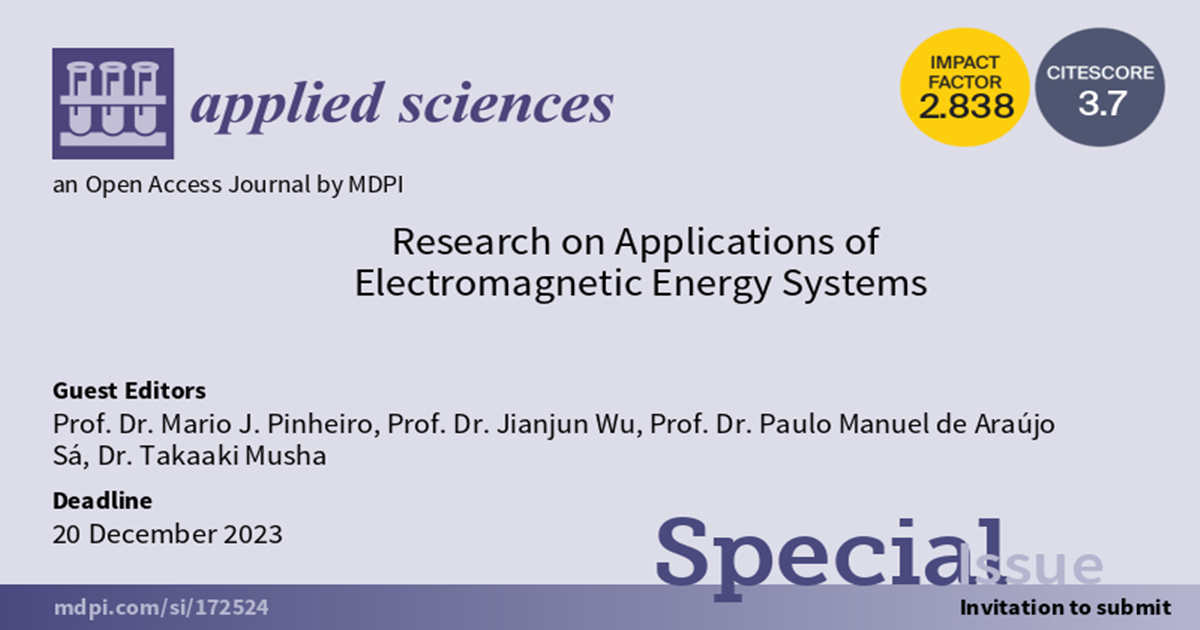Research on Applications of Electromagnetic Energy Systems
A special issue of Applied Sciences (ISSN 2076-3417). This special issue belongs to the section "Energy Science and Technology".
Deadline for manuscript submissions: closed (20 June 2024) | Viewed by 3008

Special Issue Editors
Interests: quantum field theory; plasma and electromagnetic propulsion; general theory of relativity; fundamentals of electromagnetic theory
Special Issues, Collections and Topics in MDPI journals
Interests: propulsion system of electric vehicles
Special Issues, Collections and Topics in MDPI journals
Interests: plasma physics; electrodynamics; statistical mechanics; electrical discharge physics and applications; plasma propulsion; EHD thruster
Special Issues, Collections and Topics in MDPI journals
Interests: underwater acoustics; signal processing; material science; damping technology
Special Issues, Collections and Topics in MDPI journals
Special Issue Information
Dear Colleagues,
Maxwell's fundamental equations generally accurately describe the electromagnetic field, and although they are not always used properly, they have the potential to reduce environmental pollution, drive economic progress, and contribute to societal advancement during an energy transition. Moreover, they continue to inspire new and innovative applications across various fields.
The following are only several of the major topics that this Special Issue plans to cover:
- Physics of plasma thrusters (efficiency, instabilities, erosion, power requirements);
- Electromagnetic propulsion systems (for deep space exploration, hyperloop, electromagnetic harpoons, magnetoplasmadynamic thrusters, pulsed plasma thrusters);
- Measurement, instrumentation and sensors of electromagnetic energy (magnetometers, including acoustic communication and satellite communication);
- Novel power systems (wireless power transmission, linear alternators, air-core generator, magneto strictive generators, magneto hydrodynamic generators, and thermoacoustic generators);
- Quantum vacuum energy transfers to use for propulsion (Casimir Effect, EmDrive, Q thruster);
- Advanced modeling approaches using electromagnetic energy (quantum electrodynamics, electromagnetic field theory, computational electromagnetics);
- Novel applications of electromagnetic energy and forces (axial flux motors, electromagnetic shielding, electromagnetic launchers, micromachines);
- Magnetic levitation, control the flow of fluids, terahertz imaging cloaking devices, ultra-high-speed data transmission;
- Applications of novel materials to generate and control electromagnetic fields: superconductors, metamaterials, ferrofluids, magnetic shape-memory alloys, photonic crystals, magnetostriction.
This Issue aims to provide a forum for academic and professional researchers, developers, and producers to share cutting-edge findings and advance the application of electromagnetic energy systems.
Prof. Dr. Mario J. Pinheiro
Prof. Dr. Jianjun Wu
Prof. Dr. Paulo Manuel de Araújo Sá
Dr. Takaaki Musha
Guest Editors
Manuscript Submission Information
Manuscripts should be submitted online at www.mdpi.com by registering and logging in to this website. Once you are registered, click here to go to the submission form. Manuscripts can be submitted until the deadline. All submissions that pass pre-check are peer-reviewed. Accepted papers will be published continuously in the journal (as soon as accepted) and will be listed together on the special issue website. Research articles, review articles as well as short communications are invited. For planned papers, a title and short abstract (about 250 words) can be sent to the Editorial Office for assessment.
Submitted manuscripts should not have been published previously, nor be under consideration for publication elsewhere (except conference proceedings papers). All manuscripts are thoroughly refereed through a single-blind peer-review process. A guide for authors and other relevant information for submission of manuscripts is available on the Instructions for Authors page. Applied Sciences is an international peer-reviewed open access semimonthly journal published by MDPI.
Please visit the Instructions for Authors page before submitting a manuscript. The Article Processing Charge (APC) for publication in this open access journal is 2400 CHF (Swiss Francs). Submitted papers should be well formatted and use good English. Authors may use MDPI's English editing service prior to publication or during author revisions.
Keywords
- plasma and electromagnetic propulsion
- modeling of EM energy systems
- launch systems using EM fields
- materials for EM-based energy systems
- deep space missions
Benefits of Publishing in a Special Issue
- Ease of navigation: Grouping papers by topic helps scholars navigate broad scope journals more efficiently.
- Greater discoverability: Special Issues support the reach and impact of scientific research. Articles in Special Issues are more discoverable and cited more frequently.
- Expansion of research network: Special Issues facilitate connections among authors, fostering scientific collaborations.
- External promotion: Articles in Special Issues are often promoted through the journal's social media, increasing their visibility.
- Reprint: MDPI Books provides the opportunity to republish successful Special Issues in book format, both online and in print.
Further information on MDPI's Special Issue policies can be found here.






